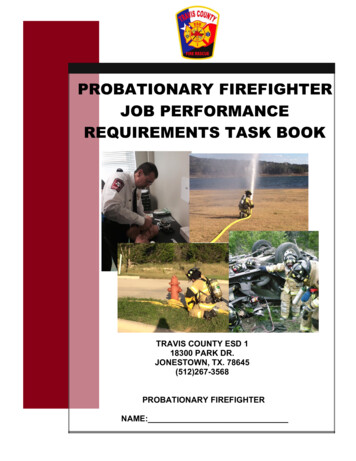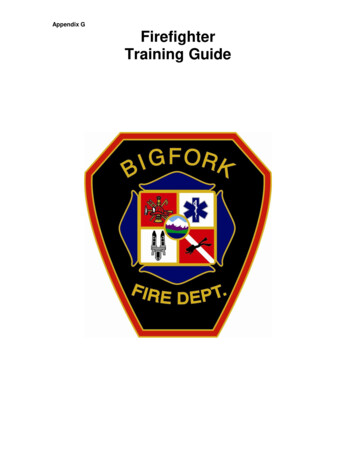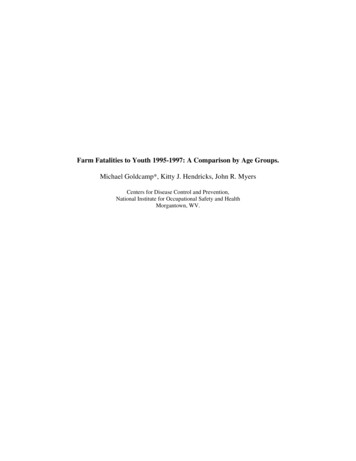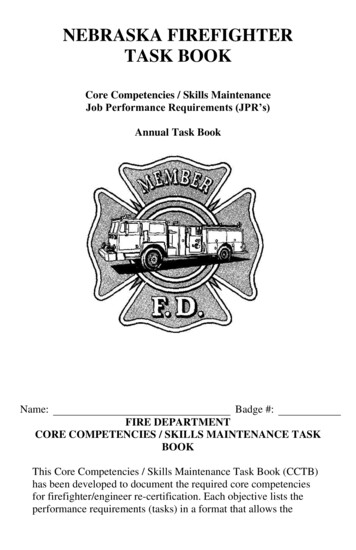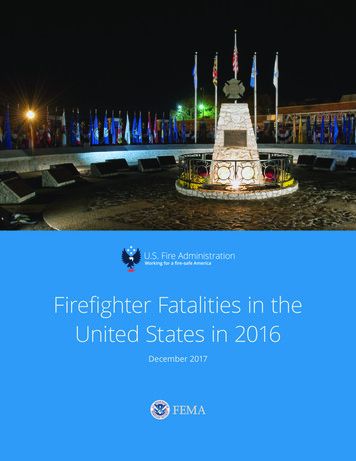
Transcription
Firefighter Fatalities in theUnited States in 2016December 2017
Firefighter Fatalities inthe United States in 2016Prepared byU.S. Department of Homeland SecurityFederal Emergency Management AgencyU.S. Fire AdministrationNational Fire Data CenterandThe National Fallen Firefighters Foundationhttps://www.firehero.orgIn memory of all firefighterswho answered their last call in 2016To their families and friendsTo their service and sacrifice
Mission StatementWe provide national leadership to foster a solid foundation forour fire and emergency services stakeholders in prevention,preparedness and response.
Table of 3Who is a firefighter?.3What constitutes an on-duty fatality?.3Sources of initial notification.4Procedure for including a fatality in the study.52016 Findings.7Career, volunteer and wildland agency deaths.8Gender.9Multiple firefighter fatality incidents.9Wildland firefighting deaths. 10Type of Duty. 13Fireground operations. 14Type of fireground activity. 14Fixed property use for structural firefighting deaths. 15Responding/Returning. 15Training. 15Nonfire emergencies. 16After the incident. 16Cause of Fatal Injury. 17Caught or trapped. 17Collapse. 17Exposure. 18Fall. 18Lost or disoriented. 19Out of air. 19Stress or overexertion. 20Struck by object. 20Suicide. 22Vehicle crashes. 22Other. 26Nature of Fatal Injury. 27Firefighter Ages. 29Deaths by Time of Injury. 31Table of Contentsi
Firefighter Fatality Incidents by Month of Year. 31State and Region. 33Analysis of Urban/Suburban/Rural Patterns in Firefighter Fatalities. 39Appendix. 41Acronyms. 45iiFirefighter Fatalities in the United States in 2016
Photo/Mark A. WhitneyAcknowledgmentsThis study of firefighter fatalities would not have been possible without the cooperationand assistance of many members of the fire service across the United States. Members ofindividual fire departments; chief fire officers; wildland fire service organizations, such asthe U.S. Forest Service, the National Park Service, the Bureau of Land Management, theBureau of Indian Affairs, the U.S. Fish and Wildlife Service; as well as the U.S. Departmentof Justice, the National Fire Protection Association, and many others, contributedimportant information to this report.The National Fallen Firefighters Foundation was responsible for compilation of a largeportion of the information used in this report. Their cooperation and work towardreducing firefighter deaths is gratefully acknowledged.The ultimate objective of this effort is to reduce the number of firefighter deathsthrough an increased awareness and understanding of their causes and how they can beprevented. Firefighting, rescue and other types of emergency operations are essentialactivities in an inherently dangerous profession, and unfortunate tragedies do occur.These are the risks that all firefighters accept every time they respond to an emergencyincident. However, the risks can be greatly reduced through efforts to improve training,emergency scene operations, and firefighter health and safety.BackgroundFor 40 years, the U.S. Fire Administration (USFA) has tracked the number of firefighterfatalities and conducted an annual analysis. Through the collection of information onthe causes of firefighter deaths, the USFA is able to focus on specific problems and directefforts toward finding solutions to reduce the number of firefighter fatalities in the future.This information is also used to measure the effectiveness of current programs directedtoward firefighter health and safety.Several programs have been funded by the USFA in response to this annual report. Forexample, the USFA has sponsored significant work in the areas of general emergencyvehicle operations safety, fire department tanker/tender operations safety, firefighterincident scene rehabilitation, and roadside incident safety. The data developed for thisreport are also widely used in other firefighter fatality prevention efforts.In addition to the analysis, the USFA, working in partnership with the National FallenFirefighters Foundation (NFFF), develops a list of all on-duty firefighter fatalities andassociated documentation each year. If certain criteria are met, the fallen firefighter’sAcknowledgments Background1
next of kin, as well as members of the individual’s fire department, are invited to theannual National Fallen Firefighters Memorial Service. The service is held at the NationalEmergency Training Center (NETC) in Emmitsburg, Maryland, during Fire Prevention Weekin October of each year. The 36th Annual National Fallen Firefighters Memorial Weekendwill be held Oct. 7 and 8, 2017. Additional information regarding the memorial service canbe found at https://www.firehero.org, or by calling the NFFF at 301-447-1365.Other resources and information regarding firefighter fatalities, including current fatalitynotices, the National Fallen Firefighters Memorial database, and links to the Public SafetyOfficer Benefits (PSOB) program, can be found at 2Firefighter Fatalities in the United States in 2016
IntroductionThis report continues a series of annual studies by the USFA of on-duty firefighter fatalitiesin the U.S.The specific objective of this study is to identify all on-duty firefighter fatalities thatoccurred in the U.S. and its protectorates in 2016 and to analyze the circumstancessurrounding each occurrence. The study is intended to help identify approaches thatcould reduce the number of firefighter deaths in future years.Who is a firefighter?For the purpose of this study, the term “firefighter” covers all members of organizedfire departments with assigned fire suppression duties in all 50 states; the District ofColumbia; and the territories of Puerto Rico, the Virgin Islands, American Samoa, thecommonwealth of the Northern Mariana Islands, and Guam. It includes career andvolunteer firefighters; full-time public safety officers acting as firefighters; fire police; state,territory and federal government fire service personnel, including wildland firefighters;and privately employed firefighters, including employees of contract fire departmentsand trained members of industrial fire brigades, whether full-time or part-time. It alsoincludes contract personnel working as firefighters, or assigned to work in direct supportof fire service organizations (e.g., air-tanker crews).Under this definition, the study includes not only local and municipal firefighters, but alsoseasonal and full-time employees of the U.S. Forest Service, the National Park Service,the Bureau of Land Management, the Bureau of Indian Affairs, the U.S. Fish and WildlifeService, and state wildland agencies. The definition also includes prison inmates servingon firefighting crews; firefighters employed by other governmental agencies, such as theU.S. Department of Energy; military personnel performing assigned fire suppressionactivities; and civilian firefighters working at military installations.What constitutes an on-duty fatality?An on-duty fatality includes any injury or illness that was sustained while on duty andproves fatal. The term “on duty” refers to being involved in operations at the scene of anemergency, whether it is a fire or nonfire incident; responding to, or returning from, anincident; performing other officially assigned duties, such as training, maintenance, publiceducation, inspection, investigations, court testimony or fundraising; and being on call,under orders or on standby duty (except at the individual’s home or place of business). Anindividual who experiences a heart attack or other fatal injury at home, while he or sheprepares to respond to an emergency, is considered on duty when the response begins.A firefighter who becomes ill while performing fire department duties and suffers a heartattack shortly after arriving home (or at another location) may be considered on duty sincethe inception of the heart attack occurred while the firefighter was on duty.On Dec. 15, 2003, the president of the U.S. signed the Hometown Heroes SurvivorsBenefit Act of 2003 into law. After being signed by the president, the act became PublicLaw 108-182. The law presumes that a heart attack or stroke is in the line of duty if thefirefighter was engaged in nonroutine, stressful or strenuous physical activity while onduty, and the firefighter becomes ill while on duty, or within 24 hours after engagingIntroduction3
in such activity. The full text of the law is available at i?dbname 108 cong public laws&docid f:publ182.108.pdf.The inclusion criteria for this study have been affected by this change in the law. BeforeDec. 15, 2003, firefighters who became ill as the result of a heart attack or stroke aftergoing off duty needed to register a complaint of not feeling well while still on duty in orderto be included in this study. For firefighter fatalities after Dec. 15, 2003, firefighters willbe included in this report if they became ill as the result of a heart attack or stroke within24 hours of a training activity or emergency response. Firefighters who became ill aftergoing off duty, where the activities while on duty were limited to tasks that did not involvephysical or mental stress, will not be included.A fatality may be caused directly by an accidental or intentional injury in either emergencyor nonemergency circumstances, or it may be attributed to an occupationally related fatalillness. A common example of a fatal illness incurred on duty is a heart attack. Fatalitiesattributed to occupational illnesses also include a communicable disease contractedwhile on duty that proved fatal when the disease could be attributed to a documentedoccupational exposure.Firefighter fatalities are included in this report even when death is considerably delayedafter the original incident. When the incident and the death occur in different years, theanalysis counts the fatality as having occurred in the year in which the incident took place.There is no established mechanism for identifying fatalities that result from illnesses,such as cancer, that develop over long periods of time and may be related to occupationalexposure to hazardous materials or toxic products of combustion. It has proved to be verydifficult to provide a complete evaluation of an occupational illness as a causal factor infirefighter deaths due to the following limitations: the exposure of firefighters to toxichazards is not sufficiently tracked; the often delayed long-term effects of such toxic hazardexposures; and the exposures firefighters may receive while off duty.Sources of initial notificationAs an integral part of its ongoing program to collect and analyze fire data, the USFA solicitsinformation on firefighter fatalities directly from the fire service and from a wide rangeof other sources. These sources include the PSOB program administered by the U.S.Department of Justice (DOJ), the National Institute for Occupational Safety and Health(NIOSH), the Occupational Safety and Health Administration (OSHA), the U.S. Departmentof Defense, the National Interagency Fire Center, and other federal agencies.The USFA receives notification of some deaths directly from fire departments, as well asfrom such fire service organizations as the International Association of Fire Chiefs, theInternational Association of Fire Fighters, the National Fire Protection Association (NFPA),the National Volunteer Fire Council, state fire marshals, state fire training organizations,other state and local organizations, fire service internet sites, news services, and fireservice publications.4Firefighter Fatalities in the United States in 2016
Procedure for including a fatality in the studyIn most cases, after notification of a fatal incident, initial telephone contact is made withlocal authorities by the USFA to verify the incident, its location, the jurisdiction, and thefire department or agency involved. Further information about the deceased firefighterand the incident may be obtained from the chief of the fire department, designee overthe phone, or by other forms of data collection. After basic information is collected, anotice of the firefighter fatality is posted at the National Fallen Firefighters Memorial sitein Emmitsburg, Maryland, as well as on the USFA website. A notice of the fatality is alsotransmitted by email to a large list of fire service organizations and fire service members.Information that is routinely requested from fire departments that have experienceda fatality includes National Fire Incident Reporting System (NFIRS)-1 (incident) andNFIRS-3 (fire service casualty) reports; the fire department’s own incident and internalinvestigation reports; copies of death certificates and autopsy results; special investigativereports; law enforcement reports; photographs and diagrams; and newspaper or mediaaccounts of the incident. Information on the incident may also be gathered from NFPA orNIOSH reports.After obtaining this information, a determination is made as to whether the death qualifiesas an on-duty firefighter fatality according to the previously described criteria. With theexception of firefighter deaths after Dec. 15, 2003, the same criteria were used for thisstudy as in previous annual studies. Additional information may be requested by the USFA,either through follow-up with the fire department directly, from state vital records offices,or other agencies. The final determination as to whether a fatality qualifies as an on-dutydeath for inclusion in this statistical analysis is made by the USFA. The NFFF criteria as aline-of-duty death (LODD) for inclusion in the annual National Fallen Firefighters MemorialService is made by the NFFF.Introduction5
6Firefighter Fatalities in the United States in 2016
2016 FindingsEighty-nine firefighters died while on duty in 2016, one less thanthe 2015 total of 90, and five fewer than the 94 firefighter fatalitiesin 2014. The 2016 total includes 22 firefighters who died undercircumstances that were part of inclusion criteria changes resultingfrom the Hometown Heroes Survivors Benefit Act. When not includingthese fatalities for the purposes of a trend analysis, there were 67non-Hometown Hero firefighter fatalities in 2016, the second lowestannual total since the USFA began this study.An analysis of multiyear f iref ighter fatalit y trends needs toacknowledge the changes from the December 2003 HometownHeroes Survivors Benefit Act. Some graphs and charts in this reportmay not indicate the Hometown Heroes portion of the total. However,this does not diminish the sacrifices made by any firefighter who dieswhile on duty, or the sacrifices made by his or her family and peers.In the same light, when conducting multiyear comparisons of firefighterfatalities in this report, the losses resulting from the attacks on theWorld Trade Center in New York City on Sept. 11, 2001, are sometimesalso set apart for illustrative purposes. This action is by no means aminimization of the supreme sacrifice made by these firefighters.From 1997 to 2006,there were onlythree years withfewer than 10 0firefighter fatalities;whereas, from2007 to 2016, therewere only threeyears with 100 ormore f iref ighterfatalities.Figure 1. On-duty firefighter fatalities Number of deaths400plus 1 Hometown Heroplus 17 Hometown Heroesplus 15 Hometown Heroesplus 15 Hometown Heroesplus 13 Hometown Heroesplus 14 Hometown Heroesplus 16 Hometown Heroesplus 22 Hometown Heroesplus 14 Hometown Heroesplus 9 Hometown Heroesplus 26 Hometown Heroesplus 15 Hometown Heroesplus 22 Hometown Heroes450450Year2016 Findings7
Figure 2. Firefighter fatalities per 100,000 63.53.34Number of .**The 2016 ratio will be included in the 2017 report.AveragesFrom 1990 to 2003, there was an average of 129 firefighter fatalities each yearin the U.S. (There were 117 each year when not including firefighter deaths onSept. 11, 2001.) The first full year of inclusion criteria changes resulting fromthe Hometown Heroes Survivors Benefit Act was 2004. This act resulted in anadditional average of 16 firefighter deaths each year recognized in this report.Even with this change, the many individual, group and organizational effortsto reduce firefighter deaths have resulted in fewer firefighter deaths per year.From 2004 to 2016, there was an annual average of 102 firefighter fatalities (86each year when not including Hometown Hero firefighter fatalities).Career, volunteer and wildland agency deathsIn 2016, firefighter fatalities included 23 career firefighters, 56 volunteer firefighters, and10 part-time or full-time members of wildland or wildland contract fire agencies (Figure 3).8Firefighter Fatalities in the United States in 2016
Figure 3. Career, volunteer and wildland agency deaths (2016)Firefighter fatalities89 total deathsCareer23 deathsVolunteer56 deathsRural firedepartments0 deathsRural firedepartments37 deathsUrban/Suburbanfire departments23 deathsUrban/Suburbanfire departments19 deathsWildland agency10 deathsFull time5 deathsPart time orseasonal5 deathsGenderOf the 89 firefighters who died while on duty in 2016, 87 were male and two were female.Multiple firefighter fatality incidentsThe 89 deaths in 2016 resulted from a total of 85 fatal incidents, including threemultiple firefighter fatality incidents taking the lives of seven firefighters. One structuralcollapse took the lives of three career firefighters, and two motor vehicle crashes killed,respectively, two wildland firefighters each.Table 1. Multiple firefighter fatality incidentsYearNumber of incidentsTotal number of 2009613200851820077212016 Findings9
Wildland firefighting deathsIn 2016, 15 firefighters were killed during activities involving brush, grass or wildlandfirefighting. This total includes part-time and seasonal wildland firefighters, full-timewildland firefighters, and municipal or volunteer firefighters whose deaths are related toa wildland fire (Figure 4).Figure 4. Firefighter fatalities related to wildland firefighting (2006 to 2016)4035Number of 2008200920102011201220132016YearTable 2. Firefighter deaths associated with wildland firefighting10Number offirefighters killedin multiple-deathincidentsYearTotal numberof deathsNumber offatal irefighter Fatalities in the United States in 2016
Table 3. Wildland firefighting aircraft deathsYearTotal numberof deathsNumber offatal 02009532008164200711In 2016, there were no firefighter fatality incidents from an aircraftcrash related to wildland firefighting.An excellent onlinemapping tool togeographically searchand contex tualizeU.S. f iref ighterfatalities, includinglinks to independentin-depth investigationsconduc ted by theNIOSH F ire F ighterFatality Investigationand PreventionProgram, can be foundat https://wwwn.cdc.gov/wisards/fffmap/.2016 Findings11
12Firefighter Fatalities in the United States in 2016
Type of DutyActivities related to emergency incidents resulted inthe deaths of 36 firefighters in 2016 (Figure 5). Thisincludes all firefighters who died responding to anemergency or at an emergency scene, returning froman emergency incident, and during other emergencyrelated activities. Nonemergency activities accountedfor 53 fatalities. Nonemergency duties include training,administrative activities, performing other functionsthat are not related to an emergency incident, andpost-incident fatalities where the firefighter does notexperience the illness or injury during the emergency.Figure 5. Firefighter deathsby type of duty (2016)Nonemergency60%(53)Emergency40%(36)A multiyear historical perspective relating to thepercentage of firefighter deaths that occurred duringemergency duty is presented in Table 4.Table 4. Emergency duty firefighter deathsYearPercentage of all 4673565455636464Percentage of all deathsexcluding Hometown Heroes54596377657067827072The number of deaths by type of duty being performed is shown in Table 5 and presentedgraphically in Figure 6 for 2016. Fireground duties were again the most common type ofduty for firefighters killed while on duty.Table 5. Firefighter deaths by type of duty (2016)Type of dutyReturningTrainingRespondingOn-scene nonfireOther on-dutyOn-scene fireAfterTotalNumber of deaths39101316172189Type of Duty13
Figure 6. Firefighter deaths by type of duty (2016)Returning3Training9Responding1013On-scene nonfireOther on-duty16On-scene fire17After21010203040Number of deathsFireground operationsSeventeen firefighters experienced fatal injuries during fireground operations in 2016.Of these fatalities, eight were at the scene of a structure fire, three were at the scene of avehicle fire, and six others were at the scene of a wildland or outside fire. The average ageof the firefighters killed during fireground operations was 48, with the youngest being 20years old and the oldest being 78 years old. Eight of those killed were volunteer, six werecareer and three were wildland firefighters. The nature of fatal injury while engaged infireground operations for seven of the firefighter deaths was heart attack (41 percent).The nature of fatal injury for the other 10 deaths include: asphyxiation (three), trauma(five), burns (one), and pulmonary embolism (one).Type of fireground activityTable 6 shows the types of fireground activities in which firefighters were engaged whenthey sustained their fatal injuries or illnesses. This total includes all firefighting duties onthe fireground, such as wildland firefighting and structural firefighting.Table 6. Type of activity (2016)14Water supply1Support1Search and rescue1Scene safety1Pump operations2Other2Incident command2Unknown3Advance hoselines4Firefighter Fatalities in the United States in 2016
Fixed property use for structural firefighting deathsThere were eight fatalities in 2016 where firefighters became ill or injured while on the sceneof a structure fire. Table 7 shows the distribution of these deaths by fixed property use.Table 7. Structural firefighting deaths by fixed property use urningIn 2016, 13 firefighters died or experienced an onset of symptoms while responding to orreturning from 12 emergency incidents; 10 while responding to, and three while returningfrom an incident.Table 8. Firefighter deaths while responding to or returning from an incidentYearNumber of firefighter 915200825200726TrainingIn 2016, nine firefighters died while engaged in training activities. Two of the ninefirefighters died from heart attacks. There were three deaths from traumatic injuries: oneresulting from a vehicle collision — watercraft; one from a vehicle collision — fire apparatus;and one from a fall — trauma. One firefighter died from heat exhaustion. The natureof fatal injury for the three remaining “other” training related deaths were hypertrophiccardiomyopathy, aortic rupture, and cardiac ischemia related to rhabdomyolysis. All 16 ofthe training fatalities from 2014 and 2015 were from heart attacks.For the nine firefighters who died while engaged in training activities, three firefightersdied while performing fire department mandated physical fitness training; one died whileinvolved in driver training; one died during an apparatus drill; one during search andrescue training at a local fire academy; one died after falling from a helicopter whileparticipating in a monthly “hoist training” exercise; one died during water rescue training;and one firefighter died at the station shortly after completing unspecified training of anon-routine physical nature.Type of Duty15
The average age of the nine firefighters was 46 years old. The youngest was 31, and theoldest was 63.Table 9. Firefighter fatalities while engaged in trainingYearNumber of firefighter 0812200711Nonfire emergenciesIn 2016, 13 firefighters were killed during emergency duties not related to fire. Theseresponse calls included five Emergency Medical Services (EMS) calls, four motor vehicleaccidents, two technical rescues, one hazmat incident (illicit drug lab explosion), and onerescue/extrication response call (collapse of a dock into a lake).Two of the 13 firefighters died from traumatic injuries, including one killed by a charterbus that crashed into a motor vehicle accident scene, and the second was struck by debrisfrom an illicit drug lab explosion. Two firefighters died from gun violence on two separatecalls: one EMS and one welfare check. Two firefighters died from asphyxiation, one whilediving to recover the body of a reported drowning victim and one was swept away by aflash flood while responding to a community hit hard by a violent storm. Five firefightersdied of heart attacks, and one from a stroke, who were an average of 52 years old. Theyoungest of these five firefighters was 38 years old, and the oldest wa
the inception of the heart attack occurred while the firefighter was on duty. On Dec. 15, 2003, the president of the U.S. signed the Hometown Heroes Survivors . publ182.108.pdf . The inclusion criteria for this study have been affected by this change in the law. Before . Dec. 15, 2003, firefighters who became ill as the result of a heart .


